#mitsubishi turbocharger
Text





Mitsubishi Starion Turbo GSR-III, 1982. The early first generation Station Turbo had a non-intercooler G63B 2.0 litre engine that made 145hp and the narrow body that complied with Japanese exterior dimension regulations taxing larger vehicles and engine displacement exceeding two litres
#Mitsubishi#Mitsubishi Starion Turbo GSR-III#Mitsubishi Starion#1982#turbocharged#JDM#Japanese market#Starion Turbo#concealed headlamps#1980s#red cars#narrow body
383 notes
·
View notes
Photo

📰 TAEVision Engineering 's Posts - Fri, Jan 13, 2023
TAEVision 3D Mechanical Design
• Parts AutoParts Aftermarket
D2Forged wheels tires rims
Garrett Turbochargers
HKT Corp glowplugs Mitsubishi Trucks
• Automotive Agriculture
Ford Trucks PickUp F150
MercedesBenz GClass IRON Project
01 - Data 109
Parts AutoParts Aftermarket
D2Forged wheels tires rims
▸ TAEVision Engineering's Post on Tumblr
02 - Data 557
Parts AutoParts Aftermarket
Honeywell International Co.
Garrett Turbochargers [View A]
3D State-of-the-Art Lighting Effects
▸ TAEVision Engineering's Post on Tumblr
03 - Data 247
Parts AutoParts Aftermarket
HKT Corp glowplugs
Mitsubishi Fuso Canter Trucks
▸ TAEVision Engineering's Post on Tumblr
04 - Data 457
Automotive Agriculture Farm Farms Farming
WINTER TIME [Auto] [Agri]
Ford Trucks PickUp F150 SVT Raptor OffRoad 6.2L V8 2010
▸ TAEVision Engineering's Post on Tumblr
05 - Data 289
Automotive
Machinery Agriculture Farm Farms Farming
MercedesBenz GClass GWagon OffRoad
IRON Project 08
Shöckl Suffolk County NY
▸ TAEVision Engineering's Post on Tumblr
📰 I just updated my Pressfolio:
TAEVision Mechanics's Online Portfolio - Global Data - Jan 13, 2023
▸ TAEVision Mechanics's Online Portfolio

Global Data - Jan 13, 2023
#TAEVision#engineering#3d#mechanicaldesign#parts#autoparts#aftermarket#D2FORGED#wheels#tires#rims#Garrett#turbochargers#lighting effects#HKT Corp#glow plugs#GlowPlugs#MITSUBISHI trucks#MITSUBISHI Fuso Canter#automotive#agriculture#WINTER TIME#FORD Trucks#F150 SVT Raptor#pickup#trucks#offroad#MercedesBenz#GClass#IRONProject
1 note
·
View note
Text
Car chases aren't as great as Hollywood makes them seem. On the screen, they're fun, exciting, maybe even a little sexy. In reality, you're basically constantly looking at your water temperature gauge to see if you're going to nuke a head gasket running the engine flat out for this long. Plus, you're driving something with the approximate horsepower of half a drunk bicyclist.
Sure, you could argue I brought it on myself. Stealing that prototype turbocharger from the automotive museum, in plain sight of Mitsubishi's finest security thugs, was going to get me in hot water one way or another. I just didn't think it would elevate to the level of a literal car chase, but it turns out those hard-working grunts had watched a pretty spicy action flick on the flight over, and were ready to find out what their rental hybrid Malibu could do.
In my defence, I really wanted that turbo. And it wasn't doing anyone any good, sitting in that alarmed display case. Most car parts aren't all that exciting to look at: if anything, I was giving the three-diamond crew some free marketing. This is what was on my mind as I blew one of the rear spring shackles driving over some thankfully-abandoned playground equipment while shortcutting across a minor residential development. Don't worry: the turbo was fine, buckled into a well-loved baby seat in the back of the car.
While I made it away from Japan's finest turbocharger-producing thugs, my car was not quite as lucky. I finally slid to a stop at a community centre parking lot, the force of the handbrake turn bending the corroded unibody in such a way that the doors would no longer shut. I had to hoof it from there, a prospect which the angry guards chasing me likely considered to be "too easy" and maybe even a little pathetic. They stayed behind, pleased that they had at least immobilized my shitbox. Maybe they even planned to run the license plate, a prospect which I found more than a little funny because I had punched it out of an old snow shovel the morning before.
194 notes
·
View notes
Text



The last Mitsubishi J2M "Raiden", at the Planes of Fame museum in Chino, CA. Primarily designed to defend against the B-29 Superfortress heavy bomber, the Raiden was handicapped at high altitude by the lack of a turbocharger. However, its four-cannon armament supplied effective firepower and the use of dive and zoom tactics allowed it to score occasionally.
Insufficient numbers and the American switch to night bombing in March 1945 limited its effectiveness
21 notes
·
View notes
Text
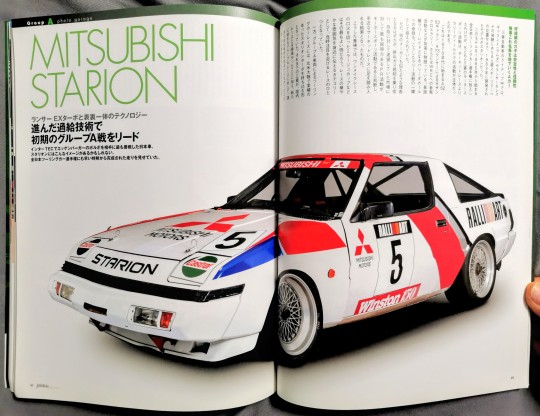

MITSUBISHI STARION
Technology that is inextricably linked to the Lancer EX Turbo
Leading early Group A races with advanced supercharging technology
The Japanese car that fought best against Eggenberger's Volvo at the Inter TEC. Starion may have such an image. In the All Japan Touring Car Championship, he showed a perfect run from an early stage.
Stability and reliability are the keys to good results A-car that makes it to the ground safely
In the lineup of Mitsubishi Motors, the model developed in 1982 was the Starion, positioned as a high-end sports coupe that was the successor to the Galant (Lambda) and Lancer Celeste.
This model was introduced in the All Japan Touring Car Championship that began in 1985, but Mitsubishi's motorsports activities were originally focused on rally fields rather than circuit races.
This is clearly evidenced by the A53/55 Galant, the Southern Cross Rally with the AR73 Lancer, and even participation in the WRC, which began in the 1970s. Participation in the long-distance rally raid from Paris to Dakar was also seen as part of these rally activities.
However, for other manufacturers, for similar reasons, the most convincing PR activity for a market that was hungry for performance while surviving emissions regulations was motorsport. It was a result of making a decision and stepping into the circuit race at hand.
In this sense, the Mirage Cup, which started the one-make race, is probably the best example. As a category that conveys the glamorous atmosphere of racing, it was one of the races that attracted attention at the time.
On the other hand, in the touring car race of Group A vehicles, the Starion Turbo, which had a proven track record in the North American continent, was brought in. One of the reasons for this was that until then, Mitsubishi had had little to do with domestic races, and that they could not find a suitable car to participate in the newly-started Group A race.
This is also the case with Nissan's Group C cars, which used the proven mechanics of the IMSA series in the form of "reverse imports."
Well, that Stallion is equipped with a G63B type 3-valve SOHC + turbocharger engine. Mitsubishi had accumulated turbocharging technology with the Lancer EX2000 for WRC. The engine type of the Lancer EX2000 Turbo is the 4G63 type (different from the 4G63 type of 4-valve DOHC used in the Lancer Evolution series later. It is the SOHC 2-valve engine that became the prototype of this), and the basic part is Stallion's
Common with the G63B type. Looking back on these circumstances, Mitsubishi had a certain amount of experience and confidence in the basic mechanisms and content that make up the vehicle.
The first Stallion that appeared in such a background was InterTEC in 1985. After that, Akihiko Nakatani, who became the main driver of the Stallion, was combined with M. Liu and Fumio Mutoh to finish 4th overall. Considering that the 1st and 2nd place was the Volvo 240 Turbo and the 3rd place was the BMW 635CS, it was a good result, what happened to the other Japanese cars?
Then, from 1986, Kunimitsu Takahashi and Akihiko Nakatani teamed up to participate in the All Japan Touring Car Championship series on a regular basis. He finished 5th in Round 1 and 3rd in Round 2, and in Round 3 at Tsukuba, he finally won his long-awaited first victory.
At this time, the opponent was Takao Wada/Aguri Suzuki's Skyline RS Turbo, and although they conceded the series championship, they were always on even terms and won the 2nd place in the series. He had become a presence respected by other entrants.
The following year, 1987, they maintained their first-class competitiveness and got off to a great start with two consecutive wins at the opening of West Japan and West Sendai. After that, he continued to lose races due to trouble, but he managed to win the series ranking 3rd place thanks to his savings in the early stages. He has proven that he is still a first class contender.
In 1988, the Skyline fleet changed to the HR31 type, the Sierra RS500 increased, and the Supra entered the war. The SOHC system engine was already severe, and the chassis performance had reached the stage of review.
In terms of results, the 2nd place in the match against Nishi-Sendai was conspicuous, and the number of cases where other division 1 cars fell behind was increasing.
On the other hand, the wide-body GSR-VR (1987) was launched on the market during this period, and the basic performance was slightly improved, but compared to the trend of rival cars, the progress of evolution was not good. He took small strides and eventually withdrew from Group A racing in 1988.
After that, Mitsubishi's motorsports activities shifted to Group A rally cars with turbo 4WD starting with the Galant VR-4, and after the release of the Lancer Evolution series, it became a WRC top contender until it captured the world title.
Even so, in 1986, when the race began in earnest, the Stallion, whose basic design was already outdated, was able to achieve such a good track record. It's nothing but Taka.
At the 1986 Inter TEC, which was the debut race, it was exciting to see the Stallion running fast and make the Volvo team say, "What is that car?"
62 notes
·
View notes
Note
1, 13, 27 👀
1: Virgin?
Nah
13: Biggest turn ons
98' Mitsubishi Lancer Evo V AWD 2L turbo engine with 300 hp and the 85' Audi Sport Quattro S1 2.1L inline-5 turbocharger with 500hp
27: A description of the girl/boy I like
Noone specifically but it'd be a girl who's introvert and has kind of a gothic style Idk
7 notes
·
View notes
Photo
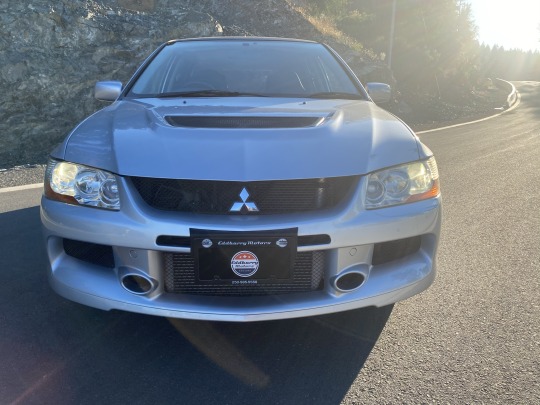
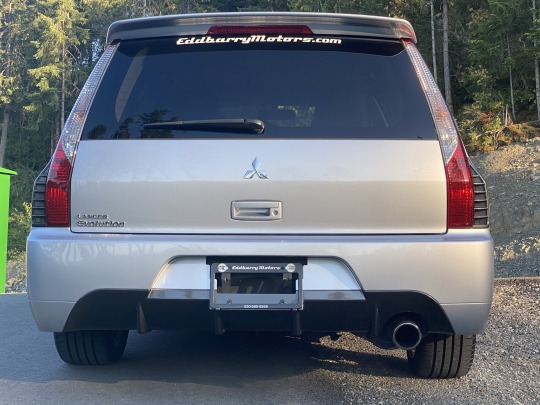
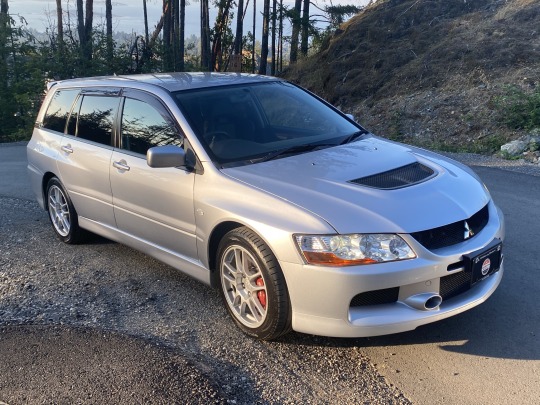



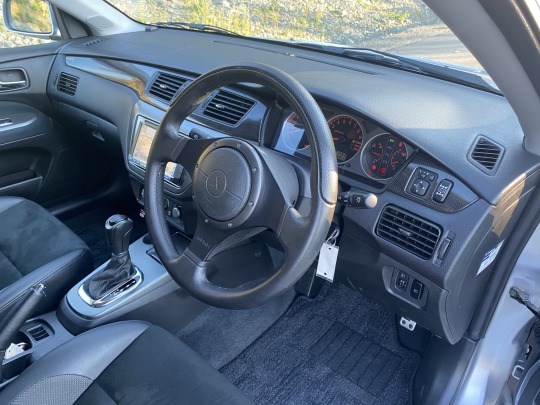


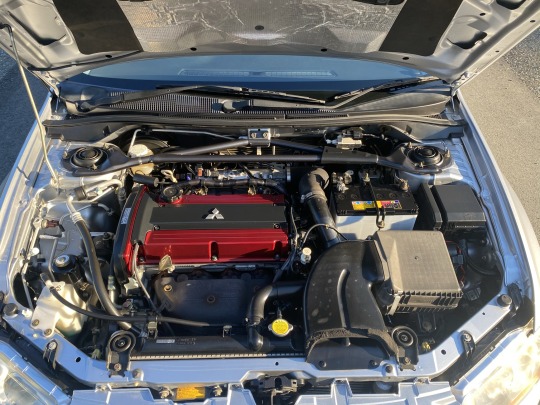
Mitsubishi Lancer Evolution IX GT-A Wagon
I don't know about you, but when I think of a wagon, I normally think of a car that's had the thrill factor turned down a notch or two. Not here. The Lancer Evolution Wagon is a fully-blown Evo in every detail. Dropped onto the same four-wheel- drive platform as the Evo IX, this luggage-lugger is about as extreme as they come.
Outside, it's no raving beauty with its Volvo-esque rear end grafted onto the chunky, sharp-edged Evo front. Inside the story's much the same. Except for the leather-wrapped gear-shifter and three-spoke steering wheel, and the supportive Recaro seats, bland grey plastic is the order of the day. Fortunately, when you fire up that 2-litre turbo it all starts to get rather more interesting.
The Wagon gets the same turbocharged 2-litre engine that debuted in the Evo IX saloon, complete with its sophisticated MIVEC variable valve timing system, but uniquely has the option of an automatic transmission to supplement the standard and excellent six-speed manual.
Bottom-end torque response is beefy and comes on hot and strong from 2500rpm, while at the top-end you can enjoy a deluge of free-flowing revs. That's the beauty of the MIVEC system, in that it allows you ready access to the considerable all that the engine has to give, but if you're stuck in slow-moving city traffic it gives you the luxury of shunt-free progress.
The six-speed manual has deliciously short throws and is ideally matched to the engine's torque curve. So how fast is the Evo Wagon? Around Japan's most popular race track, the 2.1km-long Tsukuba Circuit near Tokyo, it clocked an impressive 1min 7sec, a mere one second off the pace of its booted brother.
Just like the saloon, the Evo Wagon employs MacPherson struts on the front and a multi-link on the rear with the same rally-bred body rigidity and Bilstein dampers added for good measure. And just like the saloon, the Wagon feels rock-solid in the corners with minimum body-roll, while the ride quality is noticeably better and more compliant than that of the Evo currently on sale in Europe.
But while the Wagon inherits the four-door's Active Centre Differential (ACD) with the three-way Tarmac/Gravel/Snow control, it doesn't get the Evo IX's highly-rated Super Active Yaw Control (AYC). One Mitsubishi engineer suggested that price was the probable reason for its omission, but this car doesn't really need it. With its squared-off and heightened rear bodywork the wagon hauls an extra 70kg over the rear wheels, which works to improve the car's front to rear weight distribution.
Throw it into a corner and the Wagon turns in fast as the extra kilos at the rear get the tail moving and the nose turned-in, while the front-mounted helical LSD and ACD keep the nose in check. At the limits of adhesion, either understeer or oversteer is there for the taking. With no AYC to get in the way of a good slide, and the extra rear weight making it easier to provoke rear-end breakaway, the Wagon can be chucked into prolonged power-slides all day long. And unlike the four-door, which 'floats' its rear inside tyre in tight, fast corners, you can actually feel all four tyres (Yokohama Advan AO46s) in contact with the road, even through the quick corners.
Throw it into a corner and the Wagon turns in fast as the extra kilos at the rear get the tail moving and the nose turned-in, while the front-mounted helical LSD and ACD keep the nose in check. At the limits of adhesion, either understeer or oversteer is there for the taking. With no AYC to get in the way of a good slide, and the extra rear weight making it easier to provoke rear-end breakaway, the Wagon can be chucked into prolonged power-slides all day long. And unlike the four-door, which 'floats' its rear inside tyre in tight, fast corners, you can actually feel all four tyres (Yokohama Advan AO46s) in contact with the road, even through the quick corners.With four-piston Brembo callipers up front, sports pads and large rotors, the brakes wipe speed off instantly and feel perfectly balanced under-foot.
The Evo IX Wagon was without doubt the fastest- cornering wagon on the planet (at least until new versions of the Audi RS6 and RS4 Avants arrived to challenge its supremacy). But as Mitsubishi maked only 2500 Wagons, none officially destined for export.
26 notes
·
View notes
Text



Lew's Guy Stuff & NW Road & Marine Magazine
27m ·
Lew's Guy Stuff Says Check Out Boulder Equipment's Mahindra Tractor Sale!! All 3 Tractors come with a Free Canopy & No Payments for 90 days! Call Krista for more info (360) 866-8491 & Tell Her Lew's Guy Stuff & NW Road & Marine Magazine Sent You!!
1626 HST T/L
26HP 4X4 Hydrostatic Tractor. Mitsubishi 3 Cylinder Diesel Engine. Skid Steer Quick Attach Front Loader - 7 Year Warranty
0% Price $25,195 - $0 Down $479/mo. for 60/mo.
2638HST T/L
38HP 4X4 Hydrostatic Tractor. Mahindra mCRD 4 Cylinder Diesel Engine. Skid Steer Quick Attach Front Loader - 7 Year Warranty 0% Price $29,495 - $0 Down $559/mo. for 60/mo.
5155 T/L
55HP 4-Stroke Turbocharged mCRD 4 Cylinder Diesel Engine - NO DPF Filter. Skid Steer Quick Attach Front Loader
5 Year Warranty 0% Price $36,495 - $0 Down $691/mo for 60/mo.
2 notes
·
View notes
Photo

New Post has been published on https://www.vividracing.com/blog/top-24-best-jdm-cars-to-import-in-2024/
Top 24 Best JDM Cars To Import In 2024
youtube
Here’s our list of the top 24 Japanese quality cars that you can import to the US in 2024.
1. Nissan R34 GTR
Starting the list is the one we’ve all been waiting for, the Nissan R34 GTR which has finally hit the 25-year mark and you can now import it for the first time to the States. The Nissan R34 GTR is renowned for its performance and iconic status in the automotive world, and it is famously known for having a major role in the fourth installment of Fast & Furious. Being driven by Paul Walker is one of the reasons why the R34 GTR takes the first spot on our list, but you should import it this year because this car is often praised for its sleek design and has become a symbol of Japanese sports car engineering excellence.
2. The Nissan Silvia S15
The Nissan Silvia S15 is an amazing drift car and 2024 is the first year it can be imported. The Nissan Silvia S15 is celebrated for its sporty design and agility, and as a part of the Silvia lineage, the Nissan Silvia S15 is also known for rear-wheel-drive dynamics and balanced handling. The Nissan Silvia S15 holds a special place in the hearts of automotive enthusiasts for its style, nimble chassis, turbocharged SR20DET engine which delivers strong performance, and its sleek and aerodynamic appearance.
3. Nissan Stagea
The Nissan Stagea is unique as it combines the practicality of a station wagon with sporty and performance-oriented features. Often referred to as a “Skyline wagon” due to its resemblance to the Nissan R33/R34 Wagon, the Stagea offers versatile space for families while maintaining an emphasis on driving enjoyment. The Stagea’s blend of utility and sportiness sets it apart in the wagon category, making it an intriguing choice for those seeking a balance between practicality and performance.
4. Nissan Bluebird SSS
SSS stands for “Super Sports Sedan,” and the Nissan Bluebird SSS is known for its sporty and performance-oriented variants. The Bluebird SSS has a history of success in motorsports, contributing to its reputation for being a spirited and engaging sedan. With its more powerful engine, sport-tuned suspension, and other enhancements, the Bluebird SSS is appealing to drivers seeking a balance between comfort and performance.
Click Here to Buy Aftermarket Parts for Nissan Models
5. The Mitusbishi Lancer Evo VI
Just like some cars in this list, this is the first year that one can import this car, and here’s why you should do it, this car is a highly regarded sports sedan, known for its rally-bred performance and technological innovations. The Mitsubishi Lancer Evolution VI, often referred to as Evo VI or Evo 6 played a significant role in Mitsubishi’s success in the World Rally Championship. The Evo VI is celebrated among car enthusiasts for its rally heritage, precise handling, and the thrill it provides to drivers and it features a 4G63T engine, a turbocharged 2.0-liter powerhouse, aggressive styling, distinctive rear wing, and aerodynamic elements.
6. Mitsubishi Pajero Evo
The Mitsubishi Pajero Evolution, often referred to as Pajero Evo, is a unique and special vehicle designed for off-road racing. The car is equipped with a high-performance 3.5-liter V6 engine, full-time four-wheel drive, and advanced suspension systems tailored for challenging terrains. In addition to that, its distinctively wide stance flared wheel arches, and rugged design elements reflect its purpose as a competitive off-road machine.
7. Mitsubishi Delica
The Mitsubishi Delica is distinctive for being a versatile and unique multipurpose vehicle. The car is often categorized as a van or minivan, and it usually stands out due to its boxy and functional design, providing ample interior space and flexibility.
Click Here to Buy Aftermarket Parts for Mitsubishi Models
8. Toyota Celica T230
The Toyota Celica T230 is appreciated for its combination of stylish design, performance options, and sporty driving experience within the affordable sports coupe segment.
9. Toyota Land Cruiser J100
The Toyota Land Cruiser J100, produced from 1998 to 2007, is renowned for its robust off-road capabilities, durability, and luxury features. The J100 has excellent ground clearance, advanced suspension systems, sophisticated off-road technology, a luxurious interior, powerful performance, and the enduring reliability characteristic of the Land Cruiser lineage making it highly capable in challenging terrains.
10. Toyota Crown S170
The Toyota Crown S170 (which comes with either a 1jz engine or a 2jz engine) is recognized for its combination of elegance, advanced technology, and a smooth driving experience. The S170 features a sophisticated and refined exterior design, comfort, and interior quality, which makes it a popular choice among those seeking a premium sedan experience.
11. Toyota MRS
The Toyota MR-S, known as the MR2 Spyder in some markets, is a compact mid-engine sports car that was produced from 1999 to 2007. The car has a convertible design which adds to the car’s sporty and open-air driving appeal. The Toyota MR-S remains appreciated by enthusiasts for its unique design, convertible option, and the driving dynamics typical of mid-engine sports cars.
12. Toyota Celica TRD
Toyota Celica TRD (Toyota Racing Development) refers to performance-enhanced versions of the Toyota Celica that have been modified or upgraded by Toyota’s in-house tuning division. TRD typically focuses on improving various aspects of the car, including engine performance, suspension, brakes, and aesthetics.
13. Toyota Caldina
The Toyota Caldina is a compact wagon that was produced by Toyota from 1992 to 2007. The Toyota Caldina’s combination of practicality, turbocharged engine options, and in some cases, sporty variants, made it a noteworthy choice in the compact wagon segment during its production years. This practicality is the reason why the Caldina made this list.
14. Toyota Chaser
The Toyota Chaser is a mid-sized sedan that gained popularity for its combination of performance, comfort, and styling. The Toyota Chaser holds a special place among enthusiasts who appreciate a balance of sportiness and practicality in a mid-sized sedan. The car remains an iconic model in the history of Japanese performance sedans
15. Toyota Levin (If you have seen the initial D, you know this car)
The Toyota Levin is a compact sedan that has been a part of Toyota’s lineup for several decades. The Levin has a long history of being associated with sportier variants of the Toyota Corolla. It often represents a more performance-oriented and stylish version of the Corolla lineup. The Toyota Levin is often appreciated by drivers who seek a compact sedan with a sportier edge, combining the practicality of a sedan with an engaging driving experience.
16. Toyota Hilux Surf
The Toyota Hilux Surf is an SUV model that shares its heritage with the Toyota Hilux pickup truck. The Hilux Surf is well-regarded for its off-road capabilities, rugged and robust design, and more. The Toyota Hilux Surf is often chosen by individuals who prioritize off-road capabilities and durability in an SUV, making it suitable for both recreational activities and daily driving in diverse conditions
Click Here to Buy Parts for Toyota Models
17. Honda s2000 AP1
The Honda S2000 AP1 is a high-performance roadster that gained popularity for its engaging driving experience and sporty design. Celebrated for its combination of high-revving performance, engaging driving dynamics, and classic roadster design, the S2000 AP1 features a convertible soft top, allowing drivers to enjoy open-air motoring
18. Honda Prelude Type S
The Honda Prelude Type S is a model that reflects Honda’s commitment to providing a more thrilling driving experience within the sports coupe category. This performance-oriented variant of the Honda Prelude is designed to offer enhanced driving dynamics and sportier features like a sport-tuned suspension system, and more.
19. Honda Civic Type R EK9
The Honda Civic Type R EK9 is a highly regarded and iconic performance variant of the sixth-generation Honda Civic, which was produced from 1996 to 2000. The EK9 is celebrated among automotive enthusiasts for its raw performance, precise handling, and the unique blend of performance and practicality that the Type R series represents.
20. Honda Acty (another Kei truck)
The Honda Acty is a series of micro vans and kei trucks manufactured by Honda since 1977. Kei vehicles are known for their compact dimensions, making them suitable for navigating crowded urban environments. The Acty is available in various body styles, including vans, trucks, and pickups, which means it caters to different commercial and personal transportation needs.
Click Here to Buy Aftermarket Parts for Honda Models
21. Mark 2 Tourer
The Mark 2 Tourer is known for its blend of comfort, performance, and reliability. In addition to that, the ride features a spacious interior, classic and elegant design, and technological features, including advanced safety systems, infotainment options, and driver assistance technologies. This car is a good choice for those seeking a well-rounded mid-size sedan.
22. Mazda RX-7 FD series 8
The Mazda RX-7 FD Series 8, also known as the third-generation RX-7, was produced from 1999 to 2002. Known for its exceptional performance. The Mazda RX-7 FD Series 8 is often considered a classic sports car and remains highly sought after by enthusiasts for its performance, distinctive design, and unmistakable rotary engine.
23. Suzuki Every Wagon
The Suzuki Every Wagon is a practical and economical choice for those seeking a compact van with efficient urban mobility. Kei vehicles, including the Every Wagon, are designed with fuel efficiency in mind. They typically feature small-displacement engines, making them economical choices for daily commuting and short-distance travel
24. Mazda Miata
And last but not least, the Mazda Miata (or as it’s called in Japan the Mazda Roadster or Eunos Roadster). The Mazda Miata is a popular and iconic two-seat convertible sports car that is celebrated for its emphasis on driving enjoyment, open-top motoring, and its role in reviving the popularity of compact sports cars. Mazda Miata has become an automotive icon that appeals to enthusiasts and casual drivers alike, and we are sure that you will enjoy it if you import it.
If you have any questions about Japanese cars, please contact the Vivid Racing team. You can reach us by phone at 1-480-966-3040 or via email at [email protected].
2 notes
·
View notes
Text

#onthisday in 1943 VF-5 stationed aboard USS Yorktown are the first to take the Grumman F6F Hellcat into combat.
@classicwabirds via Twitter
Grumman F6F Hellcat
With the Grumman F4F Wildcat in operational service and feedback being received from both their Allies and United States Navy pilots, including combat reports against the Mitsubishi A6M Zero, Grumman set to work on an improved fighter aircraft which led to the birth of the Hellcat. Whilst the cosmetic appearance to its predecessor was obvious a number of major changes separated the two aircraft. One of these saw the Wildcat's mid-wing layout replaced with a low-wing layout that provided a couple of benefits in relation to the landing gear. Firstly the landing gear was now able to be housed in the wing and secondly the landing gear could be placed further outboard resulting in a much more stable undercarriage. After evaluating the new design the United States Navy placed an order on the 30th June 1941 for four prototypes of the aircraft with a different powerplant for each. The XF6F-1 powered by a two-stage turbocharged 1,700-hp Wright R-2600-10 Cyclone 14, XF6F-2 with the turbocharged R-2600-16 engine, XF6F-3 with a two-stage turbocharged 2,000-hp Pratt & Whitney R-2800-10 Double Wasp engine and the XF6F-4 powered by the R-2800-27 and two speed turbocharger. The first of these prototypes to fly was the XF6F-1 which flew on the 26th June 1942.
The need for more fighters to reinforce the Wildcats in service took on a greater importance when during the Battle of Midway (4th June 1942 - 7th June 1942) Douglas TBD Devastators of VT-8 were all shot down, with only one pilot surviving, with VT-6 Devastators nearly succumbing to the same fate. This lead to the decision to install the most powerful engine available at the time, the Pratt & Whitney R-2800-10, into the first Hellcat airframe and a little over a month later, after the first prototype flight, on the 30th July 1942 the XF6F-3 made its first flight. However the decision had been taken before any prototypes had flown to order the aircraft as the F6F-3 Hellcat, which would have six 0.50-in machine-guns as standard armament.
When production of the Hellcat started the similarity's between the Wildcat and Hellcat would pay off as workers on the Wildcat were able to switch over to building the Hellcat with minimal fuss and on the 4th October 1942 the first production aircraft flew and another ten were built by the end of 1942. The 16th January 1943 would see the Hellcat begin to equip United States Navy Squadron VF-9 which was stationed aboard USS Essex (CV-9) although it was VF-5 stationed aboard the USS Yorktown (CV-10) which was the first to meet the Japanese in combat on the 31st August 1943 just fourteen months after the first prototype flight.
The Grumman F6F Hellcat went from strength to strength with 2,500 delivered during 1943 enabling F4F Wildcat squadrons to upgrade to the new type quickly and the Hellcat would serve alongside the Vought F4U Corsair when this aircraft entered service with the United States Navy during 1944. Despite the success of the F6F-3 version of the Hellcat, which included the F6F-3N night fighter, Grumman introduced the F6F-5 which flew for the first time on the 4th April 1944 and entered USN service shortly after. This featured the same powerplant as the F6F-3 but due to the introduction of a water injection system, which could increase power by 10% for short periods, was known as the R-2800-10W. The new Hellcat could also carry either two 1,000lb or six 5-in rocket projectiles and later production models would have two 0.50-in machine-guns, one in each wing, replaced with 20-mm cannons. A number of these were also converted into night fighters designated F6F-5N.
The Grumman Hellcat would also see service with the Fleet Air Arm and the F6F-3 was originally called the Gannet Mk I before reverting back to its original Hellcat name later and equipped No. 800 Naval Air Squadron with whom it would first see action with the Fleet Air Arm stationed aboard HMS Emperor (D98) during December 1943. Although most of the Fleet Air Arm Hellcats would serve in the Far East with the British Pacific Fleet, with twelve squadrons equipped with either the Mk I or Mk II (F6F-5) by VJ Day. Two night fighter squadrons, Nos. 891 Naval Air Squadron and 892 Naval Air Squadron based at RNAS Eglinton, were set-up with the Hellcat Mk NF.II night fighter though these would not see service during the Second World War (1939 – 1945).
When production of the Hellcat ceased in November 1945 12,275 examples had been built and the aircraft remained in service with the United States Navy, including its display team the Blue Angels and three F6F-5s performed the teams first display on the 15th June 1946, for a few years after VJ Day but was eventually replaced by the Grumman F8F Bearcat.
9 notes
·
View notes
Text
Unleash the power of the 2014 Mitsubishi Lancer Evolution Standard. With its turbocharged engine, advanced AWD, and iconic rally heritage, this is a driving experience like no other. Get behind the wheel of precision and performance today.

2 notes
·
View notes
Text

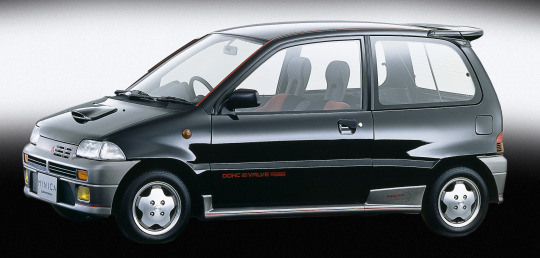

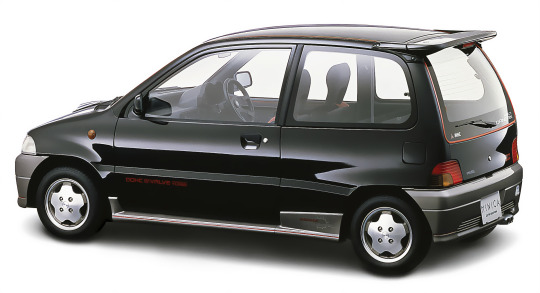
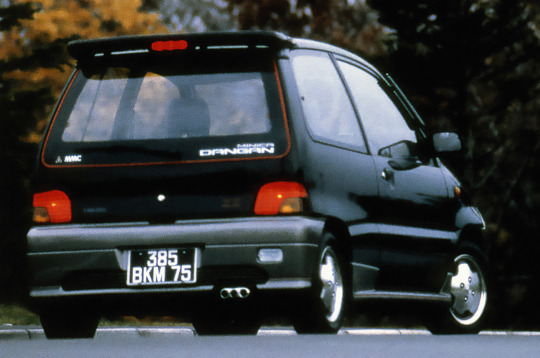
Mitsubishi Minica Dangan ZZ, 1989. The high performance version of the 6th generation of Mitsubishi's kei car was powered by the world's first mass-produced 5-valve-per-cylinder engine. The 657cc 3G83T turbo in-line 3 cylinder produced 64hp, the maximum allowed under kei-car rules
#Mitsubishi#Mitsubishi Minica#Mitsubishi Minica Dangan ZZ#Kei car#3 cylinder#world's first#5 valves#1989#micro car#small car#turbocharged
199 notes
·
View notes
Photo

📰 TAEVision Engineering 's Posts - Mon, Jan 09, 2023
TAEVision 3D Mechanical Design
• Automotive Fashion NY NYC
BMW 540i ... E39 5-Series
AlfaRomeo Giulia Spider
• Parts AutoParts Aftermarket
Garrett Turbochargers
• Tools Repair RemovalTools
RemovalGlowPlugs RemovalInjectors
• MaterialHandling Machinery Forklift Trucks
Showroom Toyota Mitsubishi
01 - Data 536
3D Design Applications
Automotive
BMW "aus Freude am Fahren"
BMW Bayerische Motoren Werke
BMW 540i 6-Speed 2000 ... E39 5-Series - M62 V8
Siena Red Metallic [362]
▸ TAEVision Engineering's Post on Tumblr
02 - Data 303
Automotive Fashion
CITY OF DREAMS 'THE ONE' BLUE SYMPHONY
NY NYC Manhattan CentralPark
AlfaRomeo Giulia Spider 1963
▸ TAEVision Engineering's Post on Tumblr
03 - Data 558
Parts AutoParts Aftermarket
Honeywell International Co.
Garrett Turbochargers [View B]
3D State-of-the-Art Lighting Effects
▸ TAEVision Engineering's Post on Tumblr
04 - Data 242
Tools AutoTools AutomotiveTools GarageTools Repair RepairTools
RemovalTools for glow plugs and injectors stuck or seized in cylinder head Diesel engines...
RemovalGlowPlugs RemovalInjectors
▸ TAEVision Engineering's Post on Tumblr
05 - Data 477
MaterialHandling Machinery Forklift Trucks
@ToyotaEquipment Showroom Toyota Mitsubishi
▸ TAEVision Engineering's Post on Tumblr
📰 I just updated my Pressfolio:
TAEVision Mechanics's Online Portfolio - Global Data - Jan 09, 2023
▸ TAEVision Mechanics's Online Portfolio

Global Data - Jan 09, 2023
#TAEVision#engineering#3d#mechanicaldesign#automotive#BMW Bayerische Motoren Werke#BMW 540i#E39 5-Series#fashion NY NYC#CITY OF DREAMS ‘THE ONE’ BLUE SYMPHONY#Manhattan#CentralPark#AlfaRomeo#GiuliaSpider#parts#autoparts#aftermarket#Garrett#turbochargers#tools#removal tools#removal glowplugs#removal injectors#materialhandling#machinery#forklift#trucks#ToyotaEquipment#TOYOTA#MITSUBISHI
2 notes
·
View notes
Text
Pyeonghwa Hwiparam III
The Hwiparam III sedan has been produced in the DPRK since 2010, it was a licensed version of the Chinese model Brilliance FSV. The car had a Mitsubishi 4A91S engine. The manufacturer indicated an engine volume of 1530 cc.
Four-door, five-seat sedan, front engine and front-wheel drive. Petrol, liquid-cooled inline four-cylinder (R4), DOHC distribution, displacement 1499 cm³, bore 75.0 mm, stroke 84.8 mm, compression 10.5, four valves/cylinder, MPI injection, non-turbocharged, output 74 kW (100 horsepower) at 5600 rpm, torque 140 Nm at 4000 rpm, automatic five-speed transmission, wheelbase 2580 mm, wheel track 1533/1502 mm, external dimensions: length 4550 mm, width 1760 mm, height 1460 mm, standby weight 1390 kg, maximum speed 180 km/h, acceleration to 100 km/h in 13.0 s. Ventilated disc brakes at the front, drum brakes at the rear.




1 note
·
View note
Text
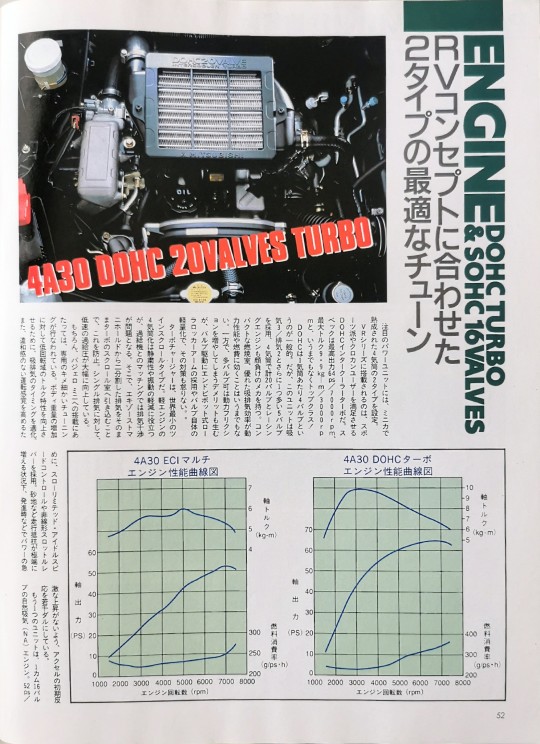
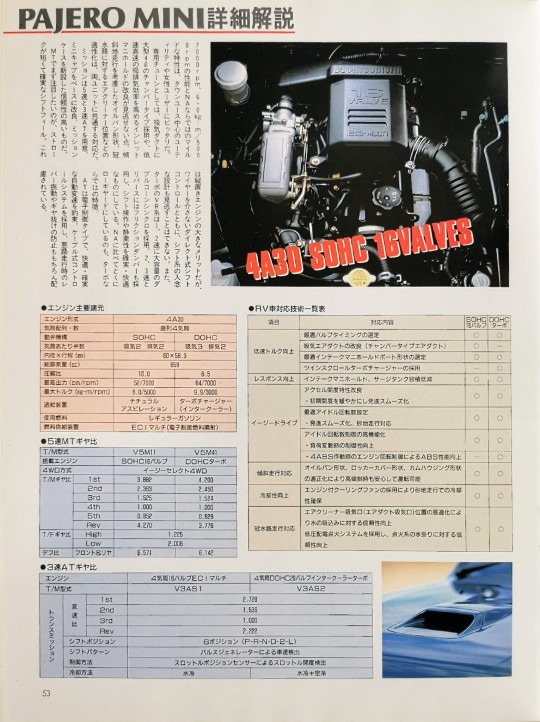
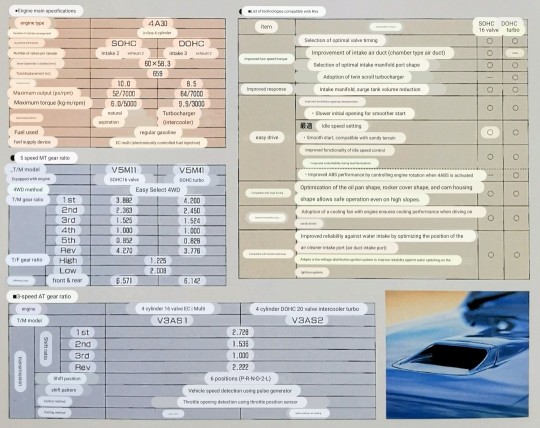
Engine specs for the 1st Gen Mitsubishi Pajero Mini.
Pajero Mini Detailed explanation
ENGINE 20VDOHC TURBO & SOHC 16VALVES
Two types of optimal tunes to suit your RV concept
Two types of 4-cylinder engines are available as the featured power units.
The VR series is equipped with a DOHC intercooler turbo that will satisfy sports enthusiasts and cross country users. The specs are top-class, with a maximum output of 64ps/7000rpm and a maximum torque of 9.9kg-m/3000rpm!
DOHC has 5 valves per cylinder.
Uno is common. However, this unit uses 3 intake/exhaust valves and an additional 5 valves, making it 4 cylinders with a total of 20 valves, and has a mechanism that rivals even racing engines. It goes without saying that the compact combustion chamber and excellent intake and exhaust efficiency improve power performance and fuel efficiency. On the other hand, having multiple valves has the disadvantage of increasing power friction, but we have taken measures to counter this by adopting an end-pivot type roller rocker arm to drive the valves and reducing the weight of the valves themselves. .
The turbocharger is the world's smallest twin-scroll type. Converting a light engine to a four-cylinder engine is useful for making it quieter and reducing vibration, but exhaust interference becomes a problem when matching it with a turbocharger. To prevent this, the exhaust gas is divided into two parts from the exhaust manifold and drawn directly into the turbo's scroll chamber. Low-speed boost pressure is significantly improved compared to single exhaust.
Of course, when installed in the Pajero Mini, special and detailed tuning has been performed. Intake and exhaust timing has been optimized to improve torque characteristics in the low rotation range despite the increased body weight.
In addition, to enhance the driving sensation without discomfort, To achieve this, a slow limited idle speed control and a non-linear throttle lever have been adopted. In situations where running resistance is extremely high, such as on sandy terrain, the power may suddenly be applied when starting, etc.
The initial response of the accelerator is made slightly duller to prevent sudden increases.
The other unit is a single overhead-cam, 16-valve naturally aspirated (NA) engine. 52ps/7000rpm、6.0kg-m/5000
The rpm performance and the mileage characteristics unique to NA are perfect for utility vehicles mainly used around town and for female users.
Not to be overlooked are the adoption of a large 4-liter chamber type in the intake duct and improvements to the inlet manifold that increase intake and exhaust efficiency at low and high speeds. The shape of the oil pan takes into account driving on slopes, and the positioning of the air cleaner relative to submerged waterways is a common feature of both units.
Transmission options include 5-speed and 3-speed AT. Improved mission based on minicab
It has a new case and is highly reliable. The first thing to pay attention to when using MT is the straw.
Short and reliable shift feel. This is a major advantage of a longitudinally mounted engine, but the careful design of the shift system, along with the direct shift control without wires, cannot be overlooked. Additionally, the VR turbo's system uses large-capacity double cone synchronizers in 1st and 2nd gears. Friction dampers are also used in 2nd and 3rd gear and reverse, making shift operations and quietness reliable and comfortable. Another characteristic unique to turbos is that they have a particularly low gearing compared to NA.
AT is an electronically controlled type that promises comfortable and reliable automatic gear shifting. A cable-type control system is used to prevent lever vibration and gear slippage when driving on rough roads.
12 notes
·
View notes
Text
Steady Growth of 6.4% CAGR in Automotive Lighting Market to USD 69 Billion by 2033
The global Automotive Turbocharger Market is expected to be worth USD 16.6 Billion. The market is expected to reach USD 41.5 Billion by 2033. It is anticipated to expand at an 9.6% CAGR throughout the forecast period.
By compressing the intake air, turbochargers can potentially increase engine efficiency by improving combustion and power production. This can be particularly crucial if governments all over the world continue to enforce tough emission standards. They should encourage automakers to create more fuel-efficient cars.
In automotive turbochargers, a turbine is powered by exhaust gas. More fuel might burn thanks to the air compressor's rotating action and additional oxygen or air it forces into the cylinder. Auto turbochargers increase the air pressure that enters the engine to increase fuel economy.
Request For a Sample of Market Research: https://www.futuremarketinsights.com/reports/sample/rep-gb-135
Variable geometry (VG) turbochargers maintain great supercharging efficiency at low to high engine rotation speeds in comparison to waste gate turbochargers. This is caused by the integration of variable mechanism stator vanes at the turbine rotor blade's input nozzle.
Combining mirror cycle direct injection gasoline engines with variable geometry turbochargers could increase a vehicle's fuel efficiency. A foundation is laid for the introduction of variable geometry turbochargers. This is caused by better knocking limit from direct injection and cooled exhaust gas recirculation.
E-turbochargers, also known as electric turbochargers, are anticipated to be quite popular throughout the review era. During the forecast period, these are anticipated to have a favorable effect on the worldwide automotive turbocharger industry.
E-turbochargers, in contrast to typical automotive turbochargers, contain an electric motor that aids in spooling up the turbocharger and removing turbo lag. As a result, it has the ability to produce electricity for the vehicle network. This might enable the alternator to turn on with less effort from the engine of the car, conserving gasoline.
The primary driver of rising engine performance demand is the need for more power density and precise torque for downsizing and down-speeding. This could improve fuel efficiency while keeping the dynamic performance of the automobiles.
Key Takeaways from the Automotive Turbocharger Market Study:
In the historical period 2018 to 2022, the global automotive turbocharger industry expanded at a CAGR of 8.7%.
The United States automotive turbocharger industry is expected to reach a valuation of USD 1.8 Billion by 2033.
Germany automotive turbocharger industry is expected to top a value of USD 1.4 Billion by 2033.
By product type, the VGT segment is expected to dominate the automotive turbocharger industry with a CAGR of 9.8% from 2023 to 2033.
China automotive turbocharger industry is anticipated to cross a valuation of USD 3.1 Billion in 2033.
Competitive Landscape
The automotive turbocharger industry has a highly competitive landscape, with a significant number of players vying for high market shares. Several significant participants in this industry comprise Continental AG, Garett Motion Inc., Cummins Inc., Mitsubishi Heavy Industries Ltd., Toyota Industries Corporation, Eaton Corporation Plc, BorgWarner Inc., IHI Corporation, BMTS Technology GmbH & Co. KG, and Weifang FuYuan Turbochargers Co., Ltd. among others.
Several businesses would concentrate on increasing the range of products they offer to cater to demands of multiple vehicle segments. Offering turbochargers for a wider range of engine sizes and configurations is one way to do this. Additionally, turbochargers are being developed for alternative fuel vehicles such as electric and hydrogen-powered cars.
A select range of participants are making investments to create strategic alliances and partnerships with other businesses in the automobile sectors. Manufacturers, suppliers, and IT firms are a handful of these.
They want to create fresh and inventive products by utilizing their resources and experience. To increase their footprint, manufacturing organizations are putting even more of an emphasis on new product launches and acquisition tactics.
Automotive Turbocharger Market Outlook by Category
By Product Type:
Waste Gate
VGT
Twin Turbo
By Vehicle Type:
Passenger Cars
LCV
HCV
Agricultural Machinery
Construction Machinery
By Fuel Type:
Gasoline
Diesel
By Sales Channel:
OEM
Aftermarket
By Actuator:
Hydraulic
Electric
Pneumatic
By Region:
North America
Latin America
Asia Pacific
Middle East & Africa
Europe
0 notes